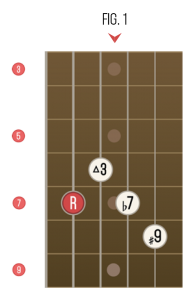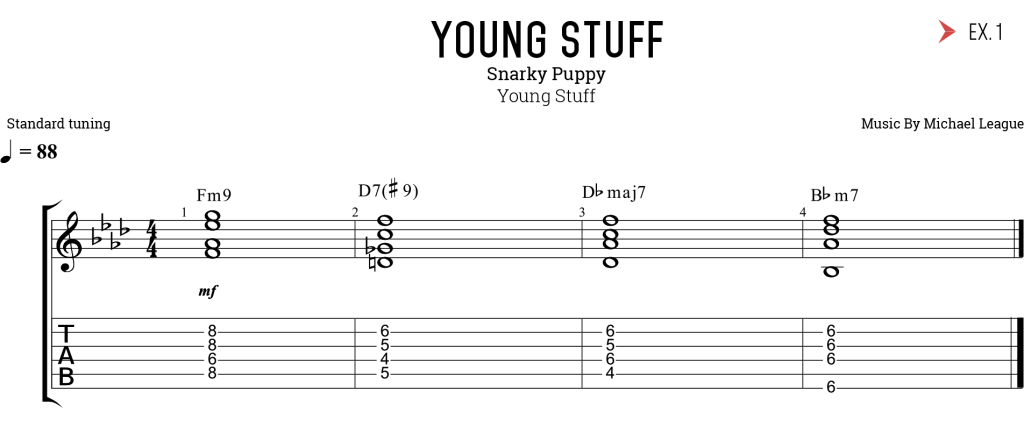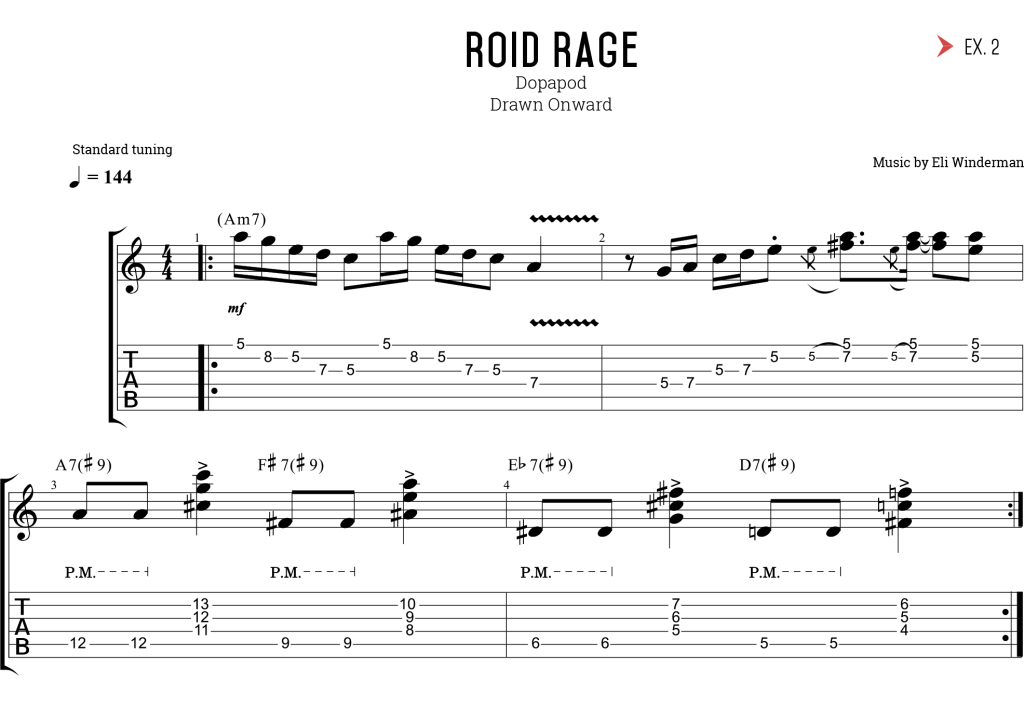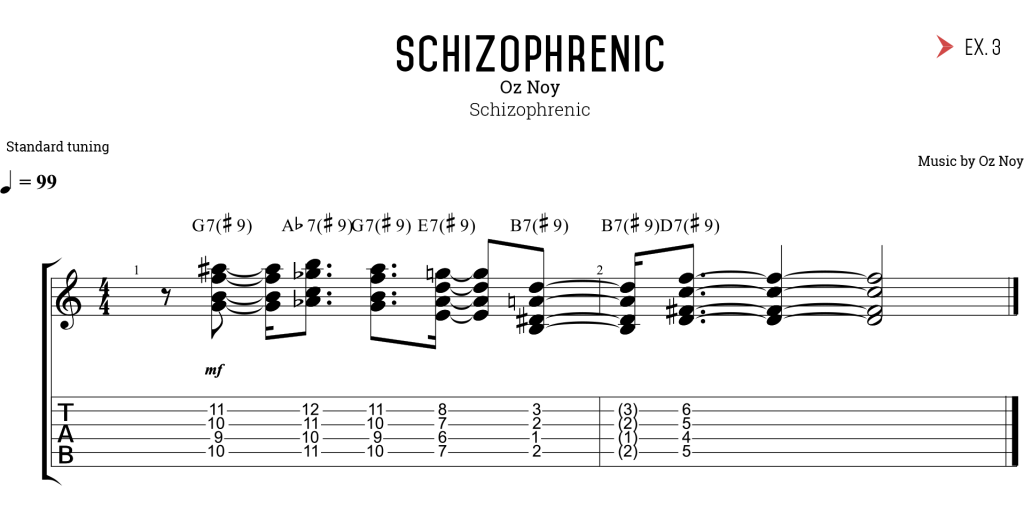A trio of clever ideas that are all about the 7#9 and will sound great in your next jam session
Hello from Toms River, NJ! In this lesson I’m going to share with you some very cool encounters I had recently that involved the infamous 7#9 (AKA the Jimi Hendrix chord) with newly Grammy-crowned guitarist Bob Lanzetti of Snarky Puppy, jamband rock star Rob Compa of Dopapod and the great Oz Noy. After this lesson you’re sure to come away with a whole new take on what the 7#9 can do for your music. To make sure we’re all on the same page, we’ll first take a quick look at what makes the 7#9 what it is. Then I’ll hip you to a trio of clever ideas that are all about the 7#9 and will sound great in your next jam session.
The 7#9 seen in Fig. 1 – in this case an E7#9 – is a dominant chord at heart. Looking at the bottom three notes starting from the 5th string, 7th fret
you’ll see an E7 (no 5th) spelled E, G#, D, which in chord tones from the E root is 1, 3, b7 respectively. That chord alone is of great value to us serving myriad functions in rock, blues, funk and jazz among other styles. But, the real magic happens when you add the #9 tension (G) as seen here on the 2nd string, 8th fret. Now you have a sinister, yet completely cool sounding chord that’s surprisingly versatile. What makes the 7#9 function so effectively and sound so good is a three-part equation:
1. First, within this dominant-based chord are both major and minor 3rds against the root. While the aforementioned G in the E7#9 is rightfully a #9 due to the distance from the root, it is also a compound minor 3rd. This is great stuff for an improviser who likes to construct lines that employ both 3’s and b3’s, while still providing a fresh harmonic backdrop for a more straight minor pentatonic approach.
2. With regards to this go-to voicing of 7#9, omitting the root creates an instance of stacked 4ths or quartal harmony, which is always a great inside or outside sounding platform. From the 3rd you have a stack of augmented 4th (G#-D) and perfect 4th (D-G) intervals giving you a maj7sus#4 sound. Speaking of major 7 sounds…
3. That’s right: The interval between the 3 and #9 is a major 7th – not what you thought you would see coming within a dom7 chord that’s meant to propel the sound of a b7! The sophisticated nature of the major 7 interval plays an ironic role in the raucous character of the 7#9 making it a very intriguing chord.
Now that you have some background on the 7#9 let’s check out some riffage…
I was recently part of a fundraising event for my dear friend John Clarizio where I put together a group of fantastic musicians that included Bob Lanzetti of Snarky Puppy who is a mutual former student of ours. While waiting to take the stage, Bob and I were considering some vamps to play where we can trade some licks. One was this sneaky four bar Fm vamp (Ex. 1) lifted from a Snarky Puppy tune called “Young Stuff” from their groundUP release where a 7#9 was used to masterfully bridge two diatonic chords in a progression that follows the stellar bass solo played by leader and principal composer, Michael League.
Following the tonic Fm (i-7) harmony in bar 1 you’ll notice a D7#9 (bII7#9 or V7alt.) in bar 2. This aptly sets up the Dbmaj7 (bVImaj7) in bar 3, which smoothly flows into Bbmin7 (iv-7) in bar 4 making for a great set of changes. The function of D7#9 in this case is a tritone sub of Ab7 that resolves to Dbmaj7 providing a nice flow of tight voice-led chords ala Steely Dan.
Just a few weeks ago another former student, Rob Compa of Dopapod, was rolling through Asbury Park on tour, when I was invited to sit in with them. Example 2 is an excerpt from one of the tunes I played called “Roid Rage” from the album Drawn Onward where the guitar lays down some sizzling licks over a driving groove that’s followed by a tantalizing descending progression of 7#9 chords creating an addictive call & response between the melody and chord riff your ear just can’t enough of.
Following the pentatonic ideas in bars 1-2 you’ll see a progression of four 7#9 chords! Stating with A7#9 the chords embark on a descending minor 3rd journey to F#7#9 and Eb7#9 that shifts gears to a half step descending movement ending on D7#9 making for curveball of a turnaround back to the tonic tonality. You’d be hard pressed to find another chord that can pull this off.
The final example ups the ante in both syncopation and fretboard movement in this two bar riff from an Oz Noy tune called “Schizophrenic” from his album of the same name. We played this tune together along with Keith Carlock and Steve Jenkins (my rhythm section for an upcoming TrueFire course). Once again the 7#9 is on the case and doing what it does best as seen in Example 3.
After the twists and turns Oz’s tune takes in true Oz Noy fashion, you hear this deceptive resolution point at the end of the head preceding the solos that sounds epic to say the least. Notice similar intervallic movements with Ex. 2, this time with half steps starting it off as the chords go up and down between G7#9 and Ab7#9 only to drop down a minor 3rd to E7#9. After making the jump down a 4th to B7#9 you make a final upward minor 3rd jump to D7#9 where the tune exercises a moment of space before the improvisation starts. Considering the virile nature of the soloing that this tune influences this progression of 7#9 chords serves up the perfect segue.
While the 7#9 is usually viewed as a staple for one chord funk jams as well as the quintessential Hendrix harmonic device in more than a few of his classics, you can now see it’s much more than that. Jam with these ideas and then be sure to compose your own 7#9-laced ideas. Use these three examples as catalysts and explore how you can make the 7#9 serve as a cool substitute, a hip-sounding response idea or a menacing two bar vamp that takes over your listeners ears.
Download Lesson Assets Here >>






